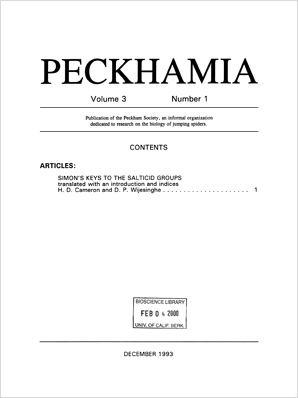
Bagheera is a genus of jumping spiders within the family Salticidae, subfamily Salticinae and subtribe Dendryphantina. The genus was first described by George Peckham & Elizabeth Peckham in 1896. The name is derived from Bagheera, a character from Rudyard Kipling's Jungle Book.

Maratus is a spider genus of the family Salticidae. These spiders are commonly referred to as peacock spiders due to the males' colorful and usually iridescent patterns on the upper surface of the abdomen often enhanced with lateral flaps or bristles, which they display during courtship. Females lack these bright colors, being cryptic in appearance. In at least one species, Maratus vespertilio, the expansion of the flaps also occurs during ritualised contests between males. The male display and courtship dance are complex, involving visual and vibratory signals.

Peckhamia is a genus of ant-mimicking jumping spiders that was first described by Eugène Louis Simon in 1900. It is named in honor of George and Elizabeth Peckham, and is considered a senior synonym of the genus Consingis.

Saitis is a genus of jumping spiders that was first described by Eugène Louis Simon in 1876. The Australian species may belong to other genera, such as Maratus.

Trechaleidae (tre-kah-LEE-ih-dee) is a family of araneomorph spiders first described by Eugène Simon in 1890. It includes about 140 described species in 16 genera. They all live in Central and South America except for Shinobius orientalis, which is endemic to Japan. Other names for the family are longlegged water spiders and fishing spiders. The family Trechaleidae is closely related to Pisauridae and Lycosidae, and the three families are sometimes referred to as the lycosid group.

Orientattus bicuspidatus, synonym Evarcha bicuspidata, is a jumping spider found only in Vietnam. It was originally placed in the genus Evarcha, but was transferred to Orientattus in 2020.

Robert Whyte is an Australian writer. He was a founding co-owner and director of the Brisbane-based multimedia firm ToadShow. After 2012 he participated in the Australian Government's new species exploration program Bush Blitz. His works include The Creek in Our Back Yard: a practical guide to creek restoration (2011) and A Field Guide to Spiders of Australia for CSIRO Publishing 2017.

Zygoballus rufipes, commonly called the hammerjawed jumper, is a species of jumping spider which occurs in the United States, Canada, and Central America. Adult females are 4.3 to 6 mm in body length, while males are 3 to 4 mm.

Peckhamia is a peer-reviewed, open-access, scientific journal covering research on jumping spiders. It is published by the Peckham Society, an international organization of naturalists and scientists with an interest in jumping spiders, named in honor of George and Elizabeth Peckham. The journal was established in 1977 and its current editor-in-chief is David E. Hill.
Maratus sceletus is a species of the genus Maratus, an Australian member of the jumping spider family. Described in 2015, they have been collected only in Wondul Range National Park in southern Queensland. The species name is derived from the Latin sceletus "skeleton", from its distinctive body pattern. Maratus sceletus is a small species, from 3.7 to 4.7 mm long. The male is black with prominent white stripes and markings across its carapace and legs.

Habronattus mexicanus is a species of jumping spider in the genus Habronattus. The species was first identified in 1896 in Mexico, after which it is named, originally allocated to the genus Habrocestum. The species has subsequently been identified in locations in North and Central America, as well as islands in the Caribbean Sea. The spider is small, but displays one of the most complex sexual displays, including sophisticated vibatory song patterns.
Peckhamia picata, the antmimic jumper, is a species of jumping spider in the family Salticidae. It is found in North America. It specifically mimics the species Camponotus nearcticus, and does not elicit aggressive behavior from said ants.
Asagena americana, the twospotted cobweb spider, is a species of cobweb spider in the family Theridiidae. It is found in the United States, Canada, and China.

Marpissa grata is a species of jumping spider in the family Salticidae. It is found in the United States and Canada. As of 2012, it is known from Ontario in Canada, and from Florida, Iowa, Michigan, and Minnesota in the United States.
Phoroncidia americana is a species of cobweb spider in the family Theridiidae. It is found in the United States, Canada, Cuba, and Jamaica.

Titanoeca americana is a species of true spider in the family Titanoecidae. It is found in North America.

Maratus pavonis is a species of jumping spider (Salticidae), endemic to Australia, where it is found in Western Australia, New South Wales, Victoria and Tasmania. The species epithet, pavonis, derives from the Latin, pavo, pavonis, meaning "peacock".

Irura bidenticulata, commonly known as the purple-gold jumping spider, is a species of salticid. As the name implies, while females tend to take on a more dull coloration, males are characterized by their striking, shiny magenta-gold patterned bodies. Discovered in 2011, the spider had initially been mistaken for a member of the Simaetha genus. Native to regions of Southeast Asia, it was first spotted in Hainan, China, having since also been located in the Saraburi province of Thailand, Cambodia, Hong Kong, and Assam.

Peckhamia wesolowskae is a species of jumping spider in the genus Peckhamia that lives in Cuba. The species was first described in 2020 by Franklyn Cala-Riquelme, Abel Bustamante, Sarah Crews and Bruce Cutler. The spider mimics ants of the Cephalotes genus. It is a small spider, measuring between 3.3 and 4 mm in length, the female being smaller than the male. The spider is dark reddish in colour, and lacks a distinctive pattern on either the abdomen or carapace. The chelicerae are also reddish and have a distinctive concave central section which helps to distinguish the species from others in the genus. Other distinguishing characteristics for the species include the very long thin embolus of the male and the wide spermathecae in the female.















